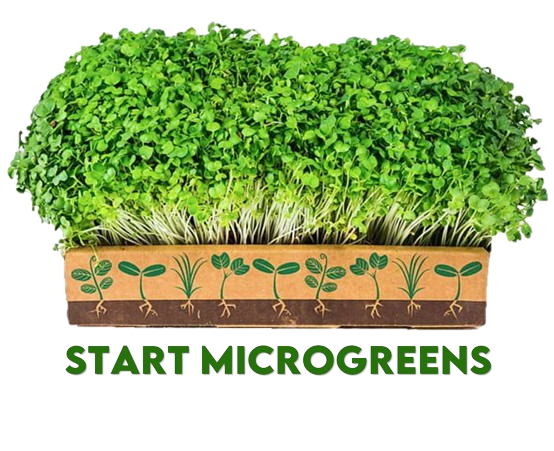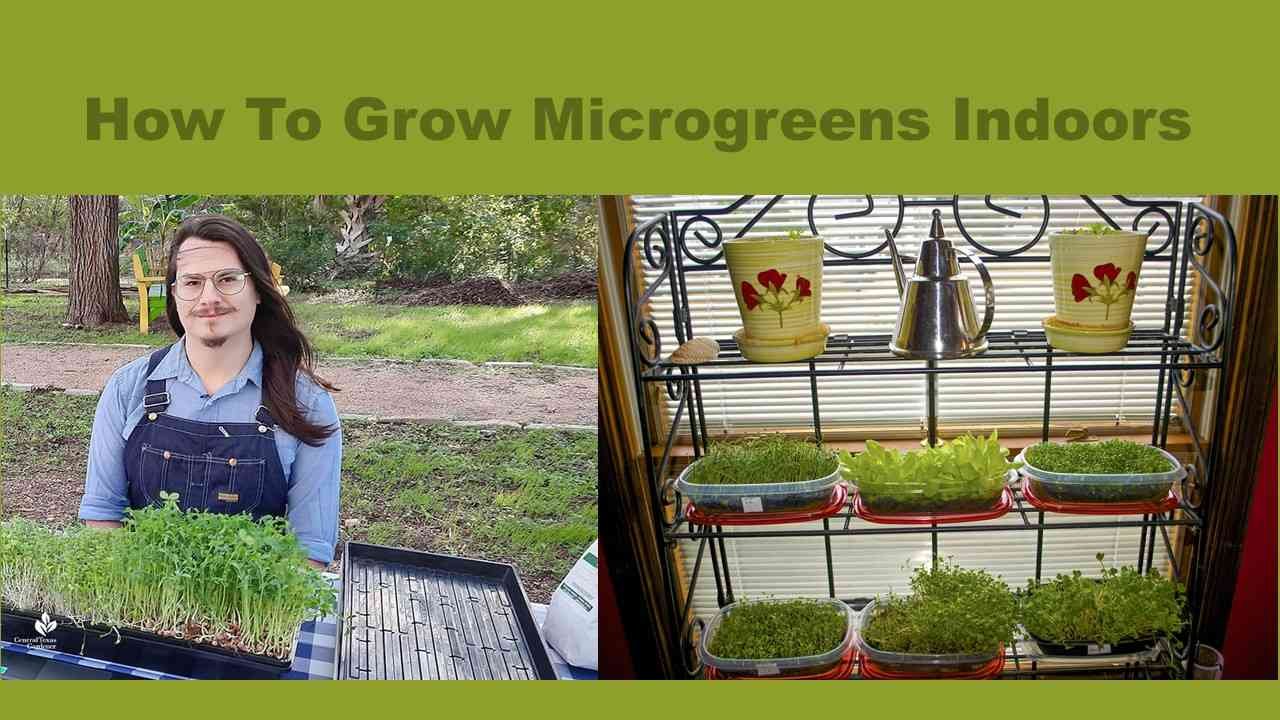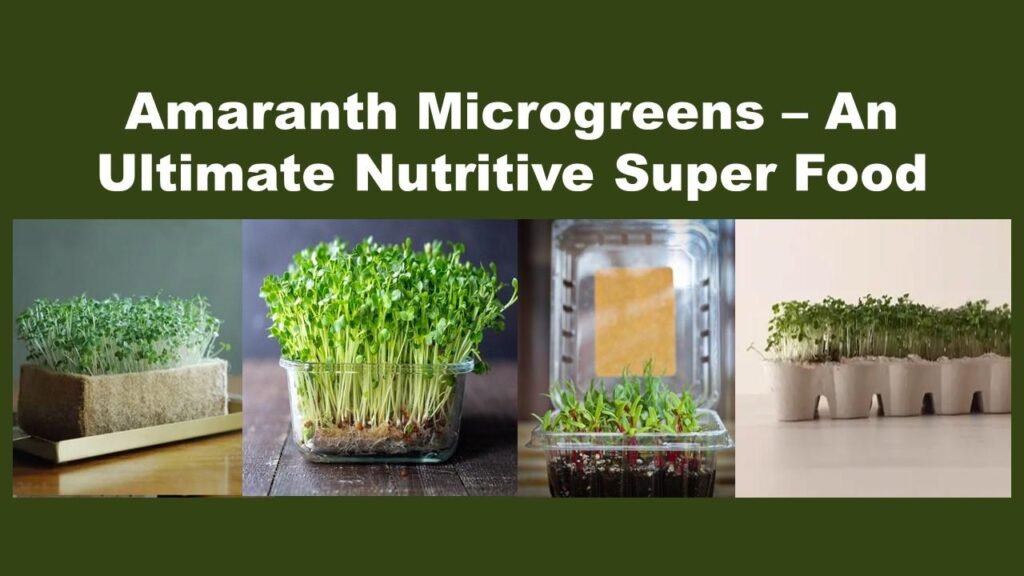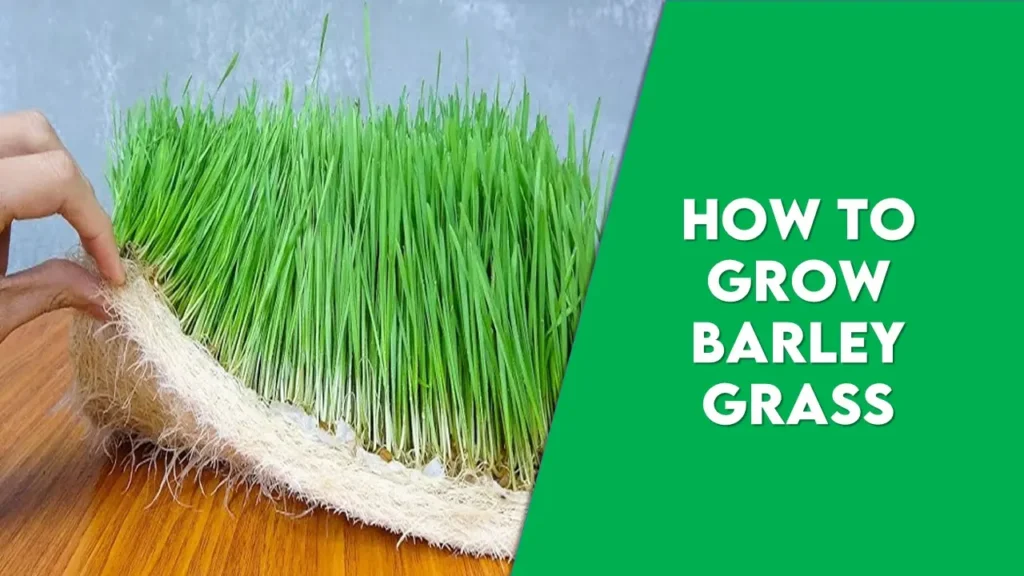How To Grow Microgreens Indoors – In The 5 Best Ways
Growing microgreens for your own consumption or commercial purpose is possible and can be done indoors even provided that specific requirements and conditions are met. Cultivation indoors has made the possibility of year-round harvest without any constraints of abnormal weather conditions. Microgreens are the tender, edible seedlings of vegetables and herbs that are harvested at a very early stage of growth, typically within 7 to 21 days after germination.
Microgreens are nutrient-rich and packed with flavor, these are not only consumed raw but also added to salads and sandwiches making them versatile. When growing indoors, requires minimal space, and not much effort and equipment is required. Just by following simple steps, you can create a mini arm at your doorsteps that will supply you with homegrown goodness. This article will tell you about how to grow microgreens indoors.

Is It Possible To Start Growing Microgreens Indoors
There are many methods on how to grow microgreens indoors. In the present scenario of rising interest and demand for gardening, the process of growing microgreens has innovated different ways to start their cultivation both indoors and outdoors. There is increased concern for health these days and nutrient-rich foods have been on the trend among which microgreens are one. Is it possible to start this cultivation process in an indoor environment? Of course yes and why not?
The recent technological innovations especially in the field of agriculture have turned every impossibility into a possible outcome. The innovations are made in a way that is not only possible but also easy and convenient for every beginner to start with. In this article, we shall find out what available methods and possibilities for cultivating them especially indoors.
Different Methods Of How To Grow Microgreens Indoors
Tray method / Flat Method
- The tray or flat method is the easiest approach to growing microgreens indoors. To begin, select shallow trays or flats with drainage holes to ensure proper water drainage. The containers can be made of plastic or reusable containers can also be used.
- Before starting, it is important to clean and sterilize them. Next, fill the trays or flats with a suitable growing medium such as potting soil, coconut coir, or peat moss. Ensure the medium is evenly spread and lightly moistened before planting the seeds.
- Scatter the seeds evenly across the surface of the growing medium, taking care not to overcrowd them. Gently press the seed into the soil, but avoid burying them too deep, as this will hinder germination.
- Water the seeds gently using a spray bottle or the watering can with a fine rose attachment. Aim to keep the soil consistently wet but not waterlogged, as excess moisture can lead to mold or fungal growth.
- Be cautious not to disturb the seeds while watering, as they are delicate at this stage of growth. Place the trays or flats in a location with ample natural light, such as a south-facing windowsill.
- Alternatively, you can use artificial grow lights if natural light is limited. Microgreens require at least 4-6 hours of light per day to thrive, so ensure they receive adequate light exposure.
- As the microgreens grow, monitor their progress regularly, ensuring they have sufficient light, water, and ventilation.
- Thin them out if necessary to prevent overcrowding and promote airflow, which helps prevent mold or disease issues.
- Once the microgreens reach the desired size, typically within 7-21 days depending on the variety, they are ready for harvest. Use sharp scissors or shears to cut the microgreens just above the soil line.
- Rinse the harvested microgreens gently and pat them dry before storing them in clean, airtight containers in the refrigerator for future use.

Jar / Container Method
- To begin, select a clean, shallow container or jar with drainage holes to allow excess water to escape. These containers can be recycled items or purpose-made pots, as long as they are appropriately sized for the amount of microgreens you intend to grow.
- Once you have your container, add a layer of moist growing medium to the bottom. This could be potting soil, coconut coir, or any other suitable medium.
- Ensure the medium is evenly spread and lightly packed to provide a stable base for the seeds.
- Scatter the seeds evenly over the surface of the growing medium, taking care not to overcrowd them.
- Gently press the seed into the medium to ensure good contact, but avoid burying them too deep. Each seed should be in direct contact with the growing medium to facilitate germination.
- Alternatively, you can use artificial grow lights if natural light is limited. Microgreens require at least 4-6 hours of light per day to thrive, so ensure they receive adequate light exposure.
- Water the seeds gently using a spray bottle or by pouring water directly into the container, being careful not to disturb the seeds.
- Aim to keep the growing medium consistently moist but not waterlogged, as excess moisture can lead to mold or fungal growth. As the microgreens grow, continue to monitor their progress regularly.
- Ensure they have sufficient light, water, and ventilation to thrive. If the container becomes overcrowded, thin out the microgreens to promote airflow and prevent mold or disease issues.
- Once the microgreens reach the desired size, typically within 7-21 days depending on the variety, they are ready for harvest. Use sharp scissors or shears to cut the microgreens just above the soil line.
- Rinse the harvested microgreens gently and pat them dry before storing them in clean, airtight containers in the refrigerator for future use.
- The jar or container method is a simple and convenient way to grow microgreens indoors, offering a continuous supply of fresh, homegrown greens right at your fingertips.
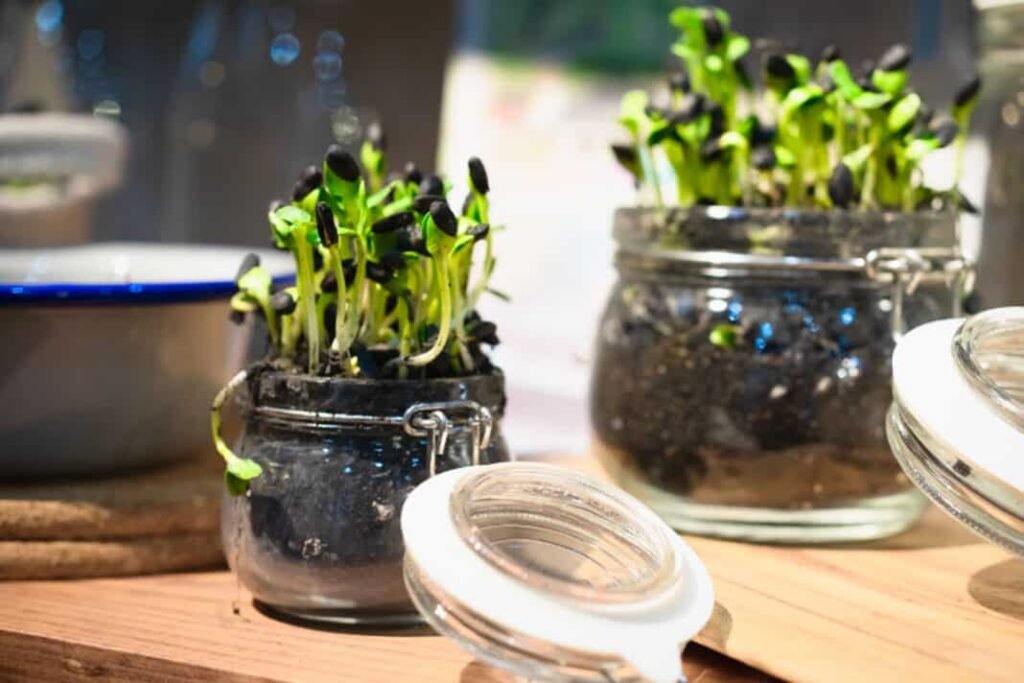
Hydroponic Method
- In this method, microgreens are grown in a nutrient-rich solution instead of supplying nutrients from external sources. To begin, select a shallow tray or container that can hold the nutrient solution.
- Ensure the container has a lid or cover to prevent evaporation and maintain humidity levels.
- Place a growing medium such as a mat or pad on top of the water to provide a stable base for the seeds.
- Scatter the seeds evenly over the surface of the growing medium, taking care not to overcrowd them. Gently press the seed into the medium to ensure good contact with the water below.
- Each seed should be in direct contact with the nutrient solution to facilitate germination and nutrient uptake. This setup has to be placed in sunlight. Alternatively, you can use artificial grow lights if natural light is limited.
- Microgreens require at least 4-6 hours of light per day to thrive, so ensure they receive adequate light exposure. Monitor the water level in the container regularly and top up as needed to maintain the proper depth.
- Ensure the nutrient solution remains at the correct pH level to support optimal plant growth.
- Adjust the pH as necessary using pH-adjusting solutions available at gardening stores. As the microgreens grow, continue to monitor their progress regularly.
- Ensure they have sufficient light, water, and nutrients to thrive. Thin out the microgreens if the container becomes overcrowded to promote airflow and prevent mold or disease issues.
- Once the microgreens reach the desired size, typically within 7-21 days depending on the variety, they are ready for harvest.
- Use sharp scissors or shears to cut the microgreens just above the growing medium.
- Rinse the harvested microgreens gently and pat them dry before storing them in clean, airtight containers in the refrigerator for future use.
- With proper attention, you will enjoy a continuous supply of fresh, homegrown microgreens year-round using this innovative technique.
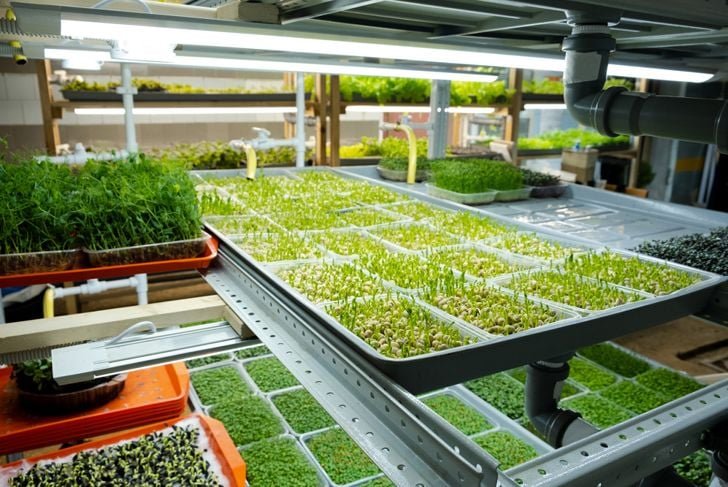
Vertical Growing Method
- This method is adopted where space is a constraint Firstly, select a vertical rack or shelving unit that is sturdy enough to support the weight of the growing containers and provide adequate space between tiers for the microgreens to grow.
- These racks can be purchased from gardening stores or easily constructed at home using materials like wood or metal. Once you have your vertical growing setup in place, choose shallow trays or containers with drainage holes for each tier of the rack.
- Fill each container with a sterile growing medium like potting soil, coconut coir, or peat moss.
- Moisten the medium before planting to ensure it’s evenly moist but not waterlogged. Scatter the seeds evenly across the surface of the growing medium in each container, taking care not to overcrowd them.
- Gently press the seed into the soil, but avoid burying them too deep. Place the containers on their respective tiers of the vertical rack, ensuring they are evenly spaced and have access to adequate light.
- Position the rack in a location with ample natural light, like near a south-facing window, or use artificial grow lights if necessary. Water the seed gently using a spray bottle or a watering can with the fine rose attachment, being careful not to disturb the seeds.
- Ensure the soil remains consistently wet but not waterlogged to promote healthy growth.
- As the microgreens grow, continue to monitor their progress regularly. Ensure they have sufficient light, water, and ventilation to thrive. Thin out the microgreens if necessary to prevent overcrowding and promote airflow.
- Once the microgreens reach the desired size, typically within 7-21 days depending on the variety, they are ready for harvest. Use sharp scissors or shears to cut the microgreens just above the soil line.
- This is about how to grow microgreens indoors through one of the most practical and easiest procedure.
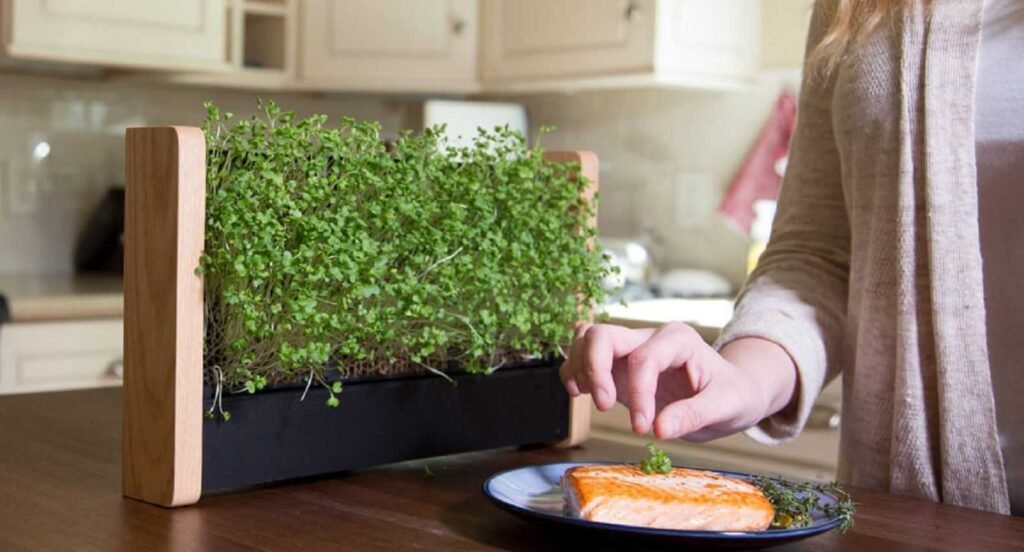
Green House Method
- The greenhouse method for growing microgreens indoors involves creating a controlled environment to optimize growing conditions and enhance plant growth.
- Firstly, select a suitable space for your greenhouse setup, ensuring it receives ample natural light or installing artificial grow lights if necessary.
- Construct or purchase a greenhouse structure that fits your available space and growing needs. Choose one that suits your indoor space and provides enough room for your microgreen trays or containers.
- Prepare the growing area within the greenhouse by setting up shelves or racks to hold your microgreen trays or containers.
- Ensure these shelves are sturdy enough to support the weight of the growing medium and microgreens. Fill trays or containers with a sterile growing medium such as potting soil, coconut coir, or peat moss.
- Moisten the medium before planting to ensure it’s evenly moist but not waterlogged. Place the trays or containers on the shelves or racks within the greenhouse, ensuring they are evenly spaced and receive adequate light exposure.
- Monitor the temperature and humidity level within the greenhouse, making adjustments as needed to maintain optimal growing conditions.
- Water the seeds gently using a spray bottle or watering can with a fine rose attachment, being careful not to disturb the seeds.
- Ensure the soil remains consistently wet, but not waterlogged to promote healthy growth. As the microgreens grow, continue to monitor their progress regularly. Ensure they have sufficient light, water, and ventilation to thrive.
- Thin out the microgreens if necessary to prevent overcrowding and promote airflow. Rinse the harvested microgreens gently and pat them dry before storing them in clean, airtight containers in the refrigerator for future use.
- This is about how to grow microgreens indoors using the most famous outdoor greenhouse technology.

.
Conclusion
Growing anything indoors, especially food is for sure a rewarding way to cultivate freshness in your space. This will help you with the year-round harvest if practiced well. Any method you choose would have its constraints and limitations. By following the appropriate steps and providing proper care, you can enjoy a continuous harvest of vibrant, flavorful microgreens right from the comfort of your own home. With dedication, patience, and a little green-thumb know-how, you can successfully grow microgreens indoors and enjoy the benefits of fresh, nutritious greens year-round.
